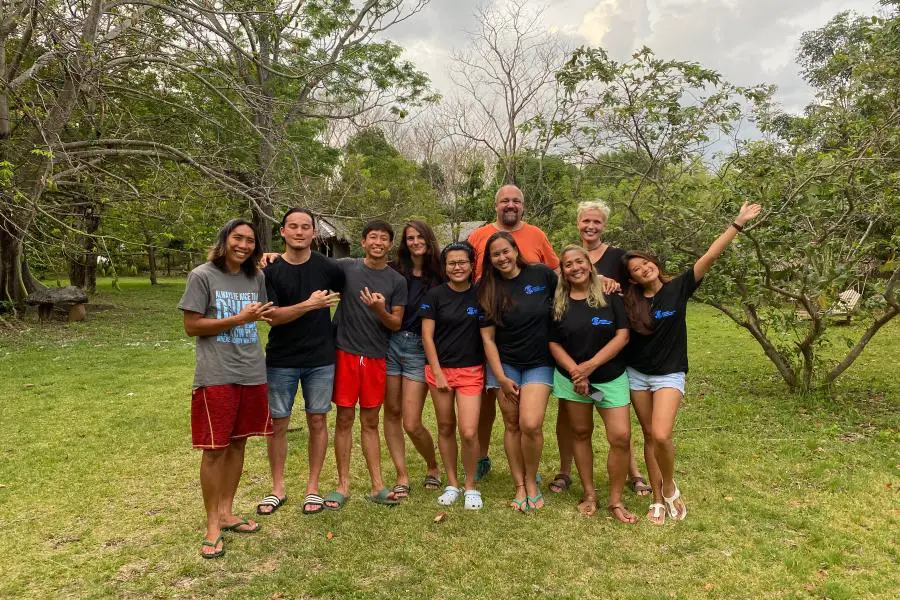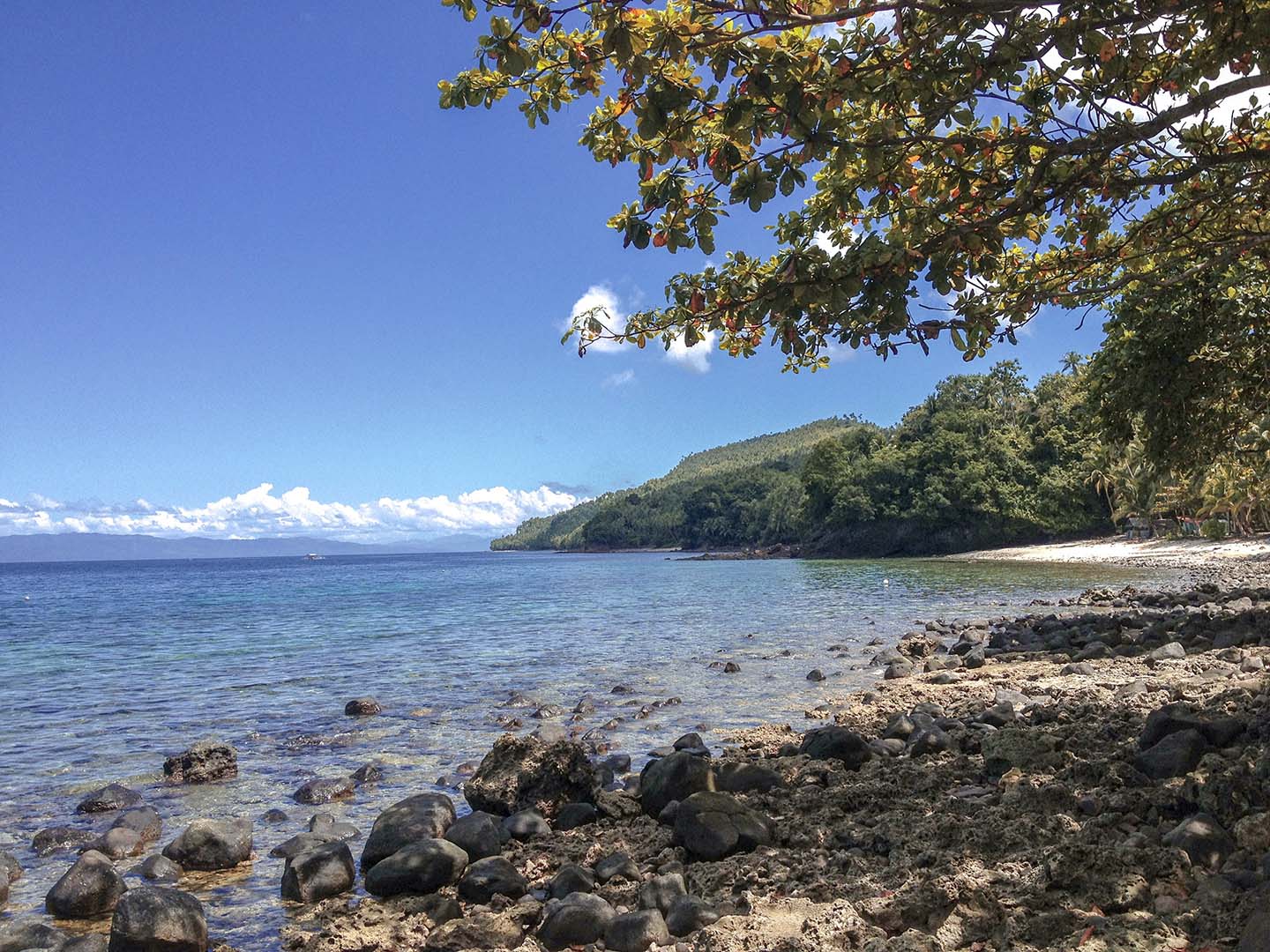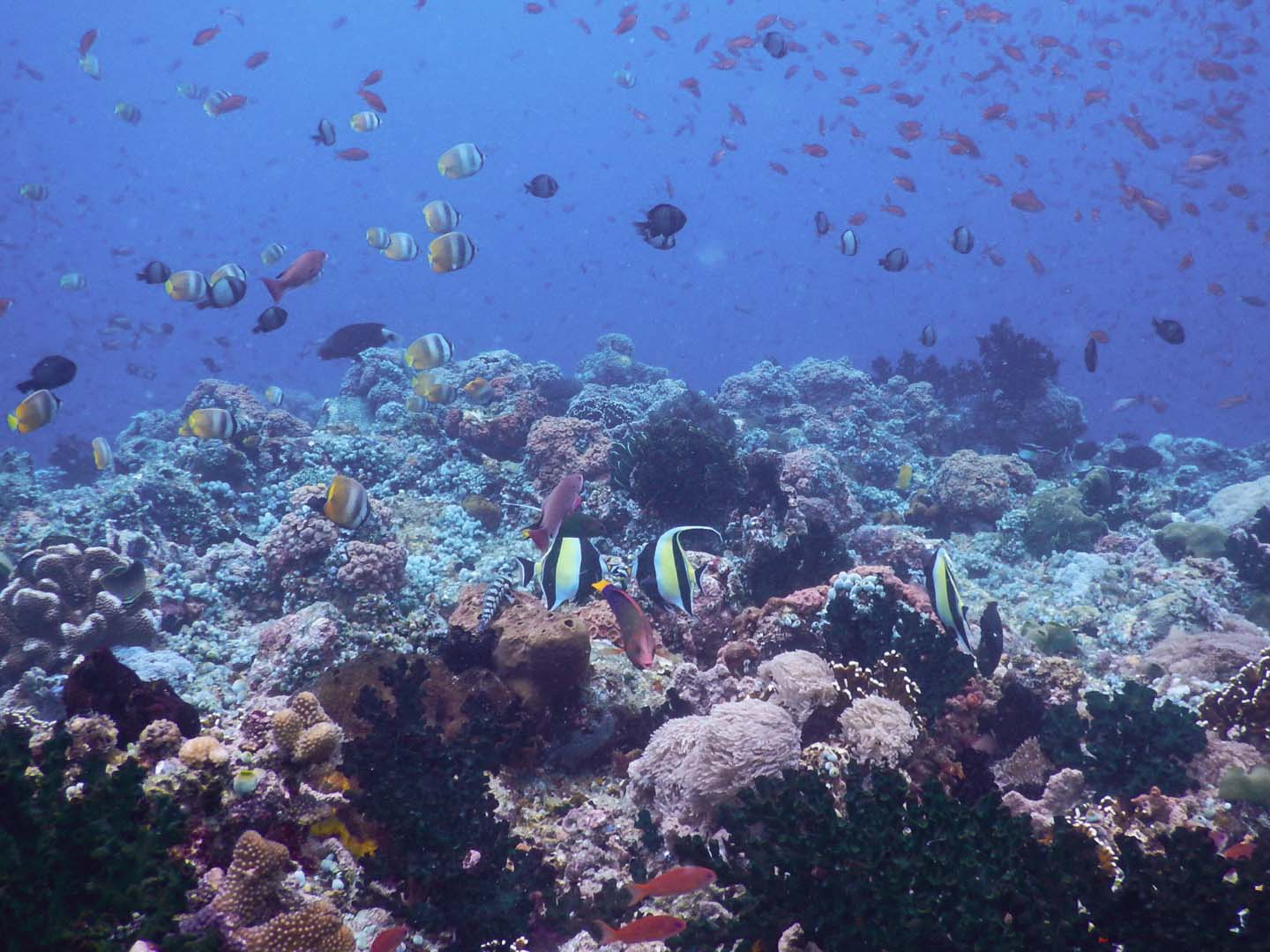Back in 2013, I learned to scuba dive through Coral Cay Conservation, which sparked my passion for diving and ocean conservation. Since then I have always been on the lookout for marine conservation programs in the Philippines.
I’ve joined various underwater cleanup activities during PADI Women’s Dive Day or International Coastal Cleanup but these were only weekend volunteer events. While they were fun and fulfilling, they did not come close to the 1-month ocean conservation volunteer program I experienced with Coral Cay.
When Marine Conservation Philippines posted online that they were offering a two-week scuba diving volunteer program for locals, I immediately reached out to see what it was all about. They sent me the details of the program and I forwarded it to my dive buddy, Maire.
The program looked amazing and we knew this was one opportunity we should not pass up. After figuring out our work schedules, we signed up to be part of the program happening in March 2022.
- About Marine Conservation Philippines
- What does Marine Conservation Philippines do?
- Scuba Diving Volunteer Program for Filipinos
- Who was volunteering?
- Who were our mentors?
- What did we learn while Volunteering in Marine Conservation Philippines?
- What was the living conditions at the MCP base?
- Who can apply for the 2-week volunteer program at Marine Conservation Philippines?
- How much did I pay as a volunteer in Marine Conservation Philippines?
- Why do you have to pay to volunteer?
- Final Thoughts
About Marine Conservation Philippines
Marine Conservation Philippines (MCP) is an NGO established in 2015 in Zamboanguita, Negros Oriental, Philippines.
MCP was founded by Søren Knudsen and Helle Larsen. The couple uprooted their lives in Europe and move to the Philippines in pursuit of their dream to protect our oceans.
As avid scuba divers and world travelers, they started to notice how the oceans were changing year after year. It was not for the better. They realized an urgent need to protect our marine ecosystems, so MCP was born.
Through volunteerism, education, and research, Marine Conservation Philippines is dedicated to preserving and protecting coastal resources in the Philippines, more specifically in the Central Visayas region where they are based.
What does Marine Conservation Philippines do?
Marine Conservation Philippines engages with local communities to educate them about the importance of the ocean and why they, as a community, need to protect the ocean that sustains them. Using science and research, they empower policymakers and stakeholders to find sustainable solutions and create policies that benefit both the people in their community as well as the environment.
Individuals who sign up for their scuba diving volunteer programs will be involved in different projects of MCP. Some projects are planned and executed by interns, while others are ongoing community-outreach projects run by the staff and volunteers.
Some of their projects include reef monitoring along the coast of Negros Oriental, weekly beach and dive clean, and planting mangrove trees, They’ve also been involved in establishing Marine Protected Areas in Zamboanguita. These volunteer-driven initiatives have truly made an impact on the local community.
Scuba Diving Volunteer Program for Filipinos
My experience in Marine Conservation Philippines started on February 28, 2022. Maire and I had arrived in Negros Oriental a few days early to do some scuba diving in Dauin. We were staying at the Aivy Mae’s dive resort so we asked the van driver to pick us up after he picks up the other volunteers from the airport.
We were expecting to be at MCP by 2 PM but because the flights were delayed our schedule got pushed back. The rest of the participants only arrived in Dumaguete after 6PMt so by the time we got to the base it was already dark.
We had a casual get-to-know-you over dinner. Then, we were told that we’ll just do orientation the next day so everyone can rest.
The following day, we headed to the common area which they call the “hex.” Breakfast was served at 7 AM and at 8 AM we had our orientation. We went over some house rules and toured the MCP compound.
We were given our daily schedule which was basically filled with activities from 7 AM to 7 PM for almost every day of the week.
Our typical day looks like this:
| Time | Activity |
| 7 AM | Breakfast |
| 8 AM | Lecture |
| 9 AM | Leave base to do 2 dives |
| 10 AM – 1 PM | Diving |
| 2 PM | Back at the base for a late lunch |
| 3 PM – 7 PM | Lecture / Courses / Freetime |
| 7 PM | Dinner |
Who was volunteering?
Our first official day was basically a getting to know your day and finding out where everyone was in terms of diving.
We were 5 in our batch: Me, Maire, Margaux, Isabelle, and Martijn. All four women were locals but Martjin who is Dutch came as a regular volunteer.
Martijn decided to fly in as soon as borders opened and he thought MCP was a good place to work on his diving and get additional diving certifications.
If you’ve been reading my blog or following my underwater adventures, you might already know Maire. She’s my usual dive buddy lately and we’ve done a lot of underwater cleanups and photography together. She’s also a rescue diver like me.
Margaux works in Save Palawan Seas which is also a Marine Conservation NGO. She convinced her boss that joining this program would be beneficial to her role there. She arrived as an open water diver and expressed that she was still an anxious diver. We convinced her to get her advanced certification, which she did. And by the time she left, she was more confident in the water.
Isabelle is Advanced Open Water Diver and is an oceanographer. She was visiting family in the Philippines when she saw the advertisement on the program. She decided to volunteer before she flew back to the USA to continue her studies.
Our backgrounds and diving experiences are very diverse but our passion for the ocean brought us together.
Who were our mentors?
Laura, the Conservation & Monitoring manager, is in charge of the volunteers. She does most of the lectures and makes sure we complete tasks and schedules are followed on time.
Ceasar also did some of our lectures and led us in a lot of underwater exercises that involved survey methodologies.
Alfred and Brian were our dive instructors and they did a lot of the underwater exercises with us. Some of us who were taking additional courses were also certified by Alfred.
In all the dives we are grouped according to our skills and experience. We’re usually split into 2-3 groups and we were assigned one mentor.
I thought this small volunteer-to-mentor ratio was great. It allowed our instructors to focus on our needs. If we were struggling with something they could immediately help us. And if we were doing well, they challenged us with more tasks.
Søren and Helle are the big bosses of MCP. They do not join our sessions but we usually hang out with them during our meal times. They make sure that we were all having a good time and that the camp is running smoothly.
Since I was doing my Nitrox course at MCP, Søren was also my instructor for my certification.
What did we learn while Volunteering in Marine Conservation Philippines?
Due to the time constraints, the program was more of an introduction to what MCP does on a day-to-day basis. We learned how to do some of their work and how it contributes to the local community.
The program gave us a glimpse of what volunteering was like in an NGO like Marine Conservation Philippines. Every day we covered a different topic about coral reefs and the issues that our oceans are facing.
To give you an idea, here’s what we learned during our 2 weeks at MCP:
Day 1: Arrival
We arrived at camp and got ourselves settled down. We didn’t have any sessions.
Day 2: Bootcamp day
After our orientation, we had our dive gear sorted out. If you did not have your own gear this was when you get fitted for the dive equipment.
We soon got our fins wet as we headed out to Malatapay. This was our most visited site as it was one of the dive sites most conducive for dive training.
Underwater in the muck area, we did some basic drills to assess where we were when it comes to diving. We did some skills test like clearing our masks, removing our masks, doing some finning exercises, and even deploying our SMBs.
The second dive was a fun dive at the more beautiful coral reef site in Malatapay. Interestingly, this was also the day I got separated from my dive buddies. So I got to practice that underwater scenario as well.
Day 3: Introduction to Coral Reef
On this day, Laura taught us about coral reefs and their importance. We learned about the different organisms and their vital functions in this incredible ecosystem.
We headed back to Malatapay to do a point and identify exercise. Our instructors basically point at different animals on the reef and let us know what roles they play in the food chain.
In the afternoon, we had the option to watch BBC Blue Planet II’s episode on Coral Reefs. It was an amazing production and I highly recommend watching it.
Day 4: Plastic Issue
On our fourth day, we learn about plastic pollution and why it is a problem.
In the morning we headed to Ducomi Pier in Dauin where MCP taught us their methodology of doing beach cleanups that made an impact. It wasn’t the ordinary cleanup that I was used to because they taught us how to audit the trash we collected.
After our beach cleanup, we also did a dive cleanup. And of course, we did it the MCP way which also included gathering trash data. I also learned a lot about how to do a proper dive cleanup.
It was a refreshing change from the cleanups I’ve done in the past where all we did was collect as much ocean trash as we can and that was it. This activity was very empowering for me as it felt like I was gathering trash data that could be useful for scientists and policymakers.
In the afternoon, we attended a lecture with Kuya Ceasar about plastic pollution. He shared with us interesting and shocking statistics on ocean plastic all over the world and discussed how it affects us. He closed the session by asking us to share ideas on how we can reduce plastic in our lives.
Day 5: Corals
The following day we learned more about corals and how they are formed. Laura taught us how to differentiate soft corals from hard corals.
For our dives, we went to Andulay since this dive site was filled with different types of corals. It was the perfect site to learn how to differentiate them.
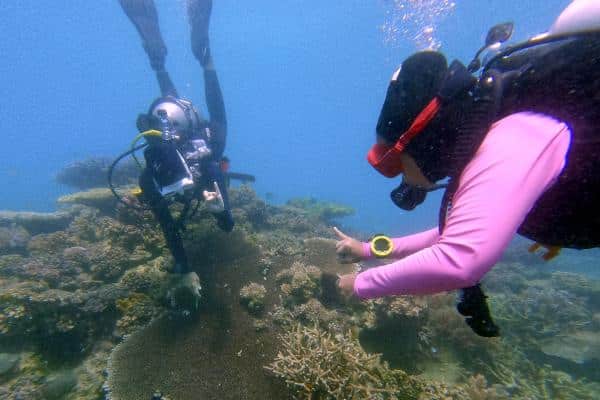
For this exercise, our instructors would point to a coral and we had to identify if it was soft or hard. It was a fun exercise but also confusing at times.
Day 6: Fun dives
Saturday was a chill day for us and we headed back to Dauin to do some fun dives.
Because Martijn and Margaux were doing their Advanced Open Water Diver course, they spent that Saturday doing their adventure dives to meet the course requirements.
Day 7: Free day
On Sunday, we headed to Dauin to have lunch at Finbar and later on to Frontemare for some Pizza and beer. We just ate a lot and laughed a lot on this day.
Day 8: Eco diver
This day was probably one of my favorites as we dived into the pros and cons of dive tourism. We learned what we should and shouldn’t if we were traveling to different places with the intention to dive.
For our dives, we focused on becoming eco-divers. We returned to Malatapay to do some challenging but fun underwater drills. We worked on our buoyancy so we can minimize our impact on the reef every time we dive. By the end of the dives, we were more conscious and skilled divers.
In the afternoon, I took my Nitrox course with Søren. I am happy to report that I passed the test and all requirements. By the end of the day, I was deemed fit to be a Nitrox Certified Diver. Yay!
Day 9: Coral ID and Coral Survey Exercise
For this day we returned to learn more about coral. This was a very geeky day as we had to learn how to ID corals underwater. While we didn’t have to know specific species there was still a lot of memorization.
Laura taught us the different types of coral growth forms like branching, tabulate, foliose, laminar, and more. We also learned about other cnidarians like zoanthids, anemone, corallimorph, hydroid, which can be found on the reef.
We also learned the corresponding hand signs for them. These come in handy while doing reef surveys and monitoring which is part of what MCP does.
We also discussed the different threats coral reefs face every day. We learned about natural predation, coral bleaching, and human activities that may affect a coral’s health.
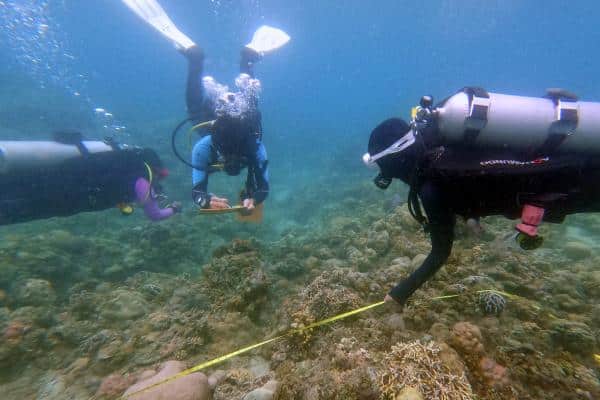
For our dives, we went to Bunbunon to test our skills in identifying corals underwater. We also learned how to do an underwater survey. Laura set up a transect line and we were asked to identify the corals or substrate along the transect.
In the afternoon, we had another lecture with Kuya Ceasar on climate change.
Day 10: Fish Identification
After learning how to identify corals, we learned how to identify fish families and their roles in the marine food web.
From butterflyfish to sharks, we learned about their identifying features to differentiate one fish family from another. We also learned the different hand signs for the fish families.
For our dives, we went to Basak and Malatapay to have another point and identify exercises. Our instructors basically pointed at the fish underwater and we had to identify them using hand signs.
At night, we joined a night dive which was one of the adventure dives for those taking the Advanced Open Water course. We went back to Malatapay and watched the nocturnal creatures come out and play.
Day 11: Fish ID + Fish Survey Exercise
We continue our fish ID mastery and learned more about fish families.
For our dives, we went to Lutoban to practice identifying the fish in that area and we were also taught how to do a fish survey. I found this to be more challenging especially when the fish are constantly moving!
In the afternoon, we were supposed to have another lecture on overfishing but the group decided to forgo this as we all felt exhausted from the previous night dive and the swim out to Lutoban.
Day 12: Fun Dives
Our last dive day was pretty chill and we had a back-to-back fun dive at Andulay and Kookoo’s. It was the perfect way to end the week. As we finally got to enjoy the reef without thinking about the scientific aspect of it.
Day 13: Free day
Another free day for us as we haven’t cleared the 18-hour no-fly rule. We decided to go to Kookoo’s for some lunch and spent the afternoon at the beach.
When we arrived back at camp we had game night and some drinks. Søren also prepared a bonfire for us and we had some legit smores.
Day 14: Going home
We went back home to Manila
To learn more about the diving itself, you can check out my post: Zamboanguita Diving: Scuba dive in a quiet town in Negros Oriental
What was the living conditions at the MCP base?
Marine Conservation Philippines is located in a botanical garden so we were surrounded by beautiful greenery every day. Since scuba diving and learning are primary activities, there is a dive shed, a compressor room, and a classroom on site.
There are also many places where you can hang out. If you’re feeling a bit introverted you can go escape to the classroom room, the library, the gym, or just sit under a tree.
Rooms and bathrooms
There are several dorm rooms. Each room can accommodate up to 5 people but during our stay, it was just Maire and me in our own room. Bathrooms are in separate locations and these are also shared among volunteers.
It was interesting to note that the dorms and bathrooms are built for foreign volunteers who are generally taller than Filipinos. The beds were built higher. The shower head and bathroom hooks were also installed higher.
I’m considered tall for a Filipino but even I found it challenging to get into bed or use the bathroom. My fellow shorter friends who stood a little over five feet said they had to do a bit of jumping to reach stuff.
Food and drinks
MCP is very generous when it comes to food. Volunteers are welcome to use the kitchen anytime. From Monday to Saturday all the meals are cooked by the MCP chef, Melba. Most meals are vegetarian except on Saturdays when there’s an option to eat meat for dinner.
There are always fruits, snacks, coffee, and tea available. But you can also bring your own food into the base so if you’re craving something else you can dig into your own stash.
On Sundays, it is Ate Melba’s rest day so you have to cook your own meal. In our case, we just headed out and treated ourselves at some resort or restaurant.
Drinking alcoholic beverages is allowed but in moderation. Since there is diving almost every day, you are discouraged from drinking heavily to avoid problems the following day. You can drink all you want on weekends during your free time.
Housekeeping
Because MCP is a working conservation camp and not a fancy resort, you basically have to cleanup after yourselves. There is no housekeeping to clean your room. There are no busboys to clear tables or wash your dishes. Laundry service is available offsite and is arranged every Monday.
Internet
While the internet is available at the base, it was highly unreliable. Especially with multiple people using it at the same time, it is very difficult to get work done. I had to wake up really early or stay up late just so I can use the internet.
Globe mobile signal was also bad so I couldn’t use my phone’s data capabilities. The other volunteers were using Smart so using the Wi-fi hotspot was not a problem for them. If you plan to work from home, make sure to get your own Wi-fi device.
Who can apply for the 2-week volunteer program at Marine Conservation Philippines?
The 2-week scuba dive volunteer program was a new program offered exclusively to Filipinos or anyone who is living in the Philippines at that time of the offer.
To join the program you must meet the following criteria:
- You are a certified scuba diver (at least Open Water Diver)
- Your last dive was less than a year ago. Or you have at least logged 20 dives.
- Ideally, you are between 18-45 years old. (They are flexible to this and make exemptions)
- You are physically fit for diving. You will be carrying your own gear and all dives are shore entries
- You understand English as most of the staff speak English and/or Bisaya)
They announced the program towards the end of 2021, when borders still hasn’t opened up due to the pandemic. I assume that since borders were still close, they had to find other ways to continue their mission and that was tapping into the local market.
But at the same time, they had to consider realistically what Filipinos can afford in terms of time and money.
For instance, MCP’s volunteer programs require a minimum of 6 weeks. For most Filipinos, this is a luxury that we cannot afford to take. People who are qualified to join the 2-week volunteer program are either studying or working, which means that they have limited time. Most Filipinos cannot leave their other commitments for so long, so 2 weeks was a more realistic timeline.
How much did I pay as a volunteer in Marine Conservation Philippines?
MCP also understood that it has to be budget-friendly to the Filipino income so the volunteers were asked to pay Php20,000 (USD400) to cover any of the living and diving expenses for 2 weeks.
For regular volunteers, a week’s stay in MCP is usually USD450 and that’s basically a month’s salary for a fresh college graduate in the Philippines. Frankly speaking, this fee is a barrier to entry for most Filipinos. Scuba diving in itself is a luxury most Filipinos cannot afford so I’m glad that they offered something that was more reasonable for a third-world country’s income earners.
The volunteer fee goes towards the following:
- the basic dorm accommodations
- 3 meals per day + snacks
- dive gear rental
- marine park fees
- marine conservation lessons and activities
- 20 dives
Why do you have to pay to volunteer?
Some might wonder why there is a volunteer fee when you’re already volunteering your time.
MCP is a non-profit organization so in order for them to keep doing what they are doing they have to find ways to cover the costs of operating.
NGOs like MCP do not get consistent funds or grants from charitable foundations or organizations. They cannot always rely on donations from private individuals or from for-profit companies so they have to look for alternatives.
Asking volunteers to cover their expenses is how they are able to operate year after year. If you would like to volunteer you can check the MCP volunteer packages on their website.
Final Thoughts
The program is one I highly recommend Filipinos would take if they have the opportunity to do so.
I learned a lot about ocean conservation and what can be done and is being done in local communities. I learned more about substrates, coral, and fish, and their importance in marine ecosystems. And most practical of them all, I learned how to be a better scuba diver so that I minimize my impact in my future dives.
I hope that MCP continues to offer this program or modify it so that it becomes more affordable and convenient to the normal Filipino diver. The lessons I’ve learned in this experience have been invaluable. My passion for ocean conservation continues to grow because of MCP.
I found it unfortunate that even if this NGO was based in the Philippines, it was mostly foreigners who were working and volunteering in MCP. Even the name has the Philippines in it and yet not a lot of Filipinos are contributing to their mission.
I think more Filipinos should be exposed to volunteer conservation programs like this because it is they who will be the best advocates of our oceans to the local communities. It will be Filipinos who will be the fiercest protectors of the seas that are right in their backyard.
I know because this has been the case for me.
At the core of every Filipino is the spirit of volunteerism. Given the chance, I think more Filipinos will be volunteering for marine conservation.
Pin this for later!
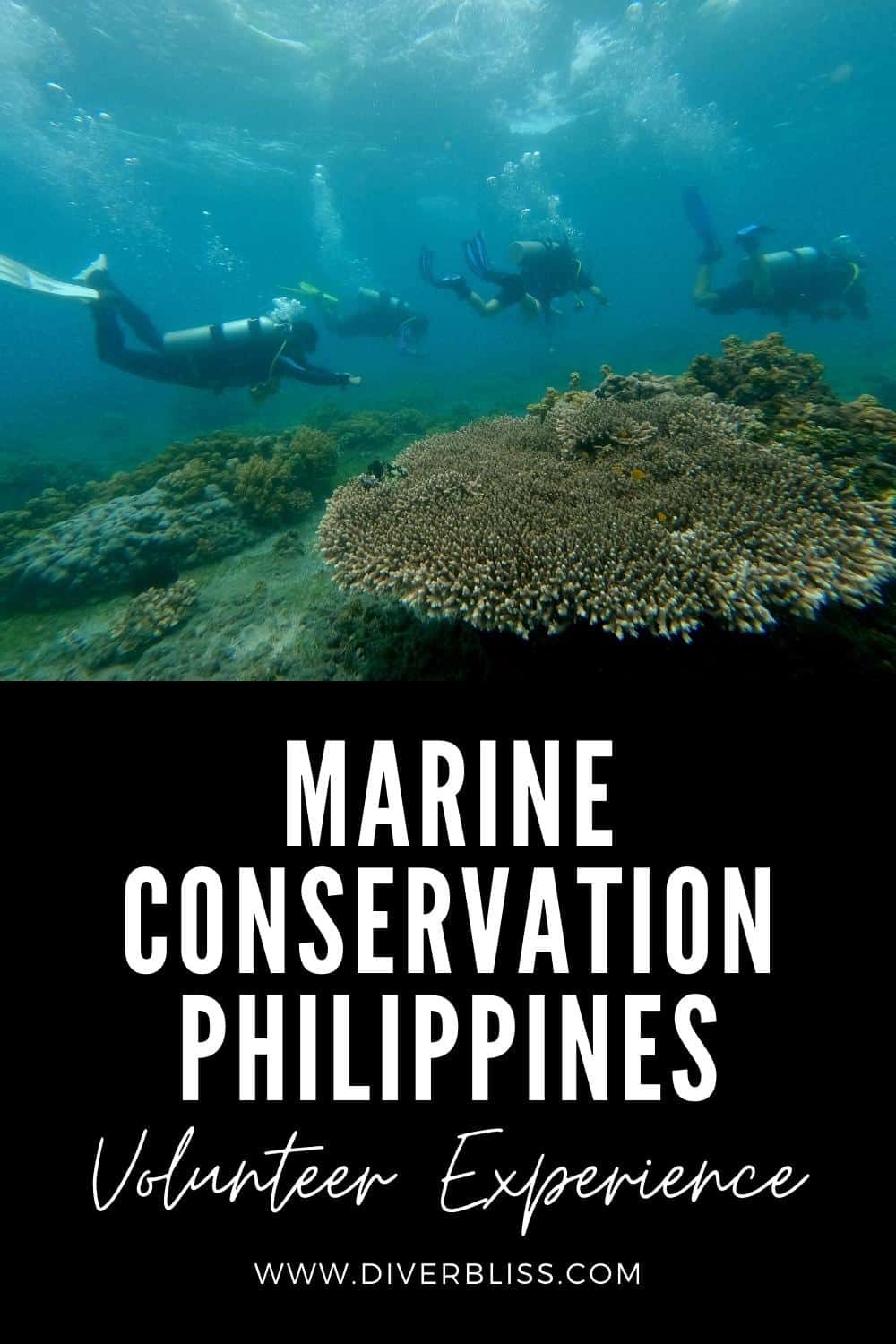
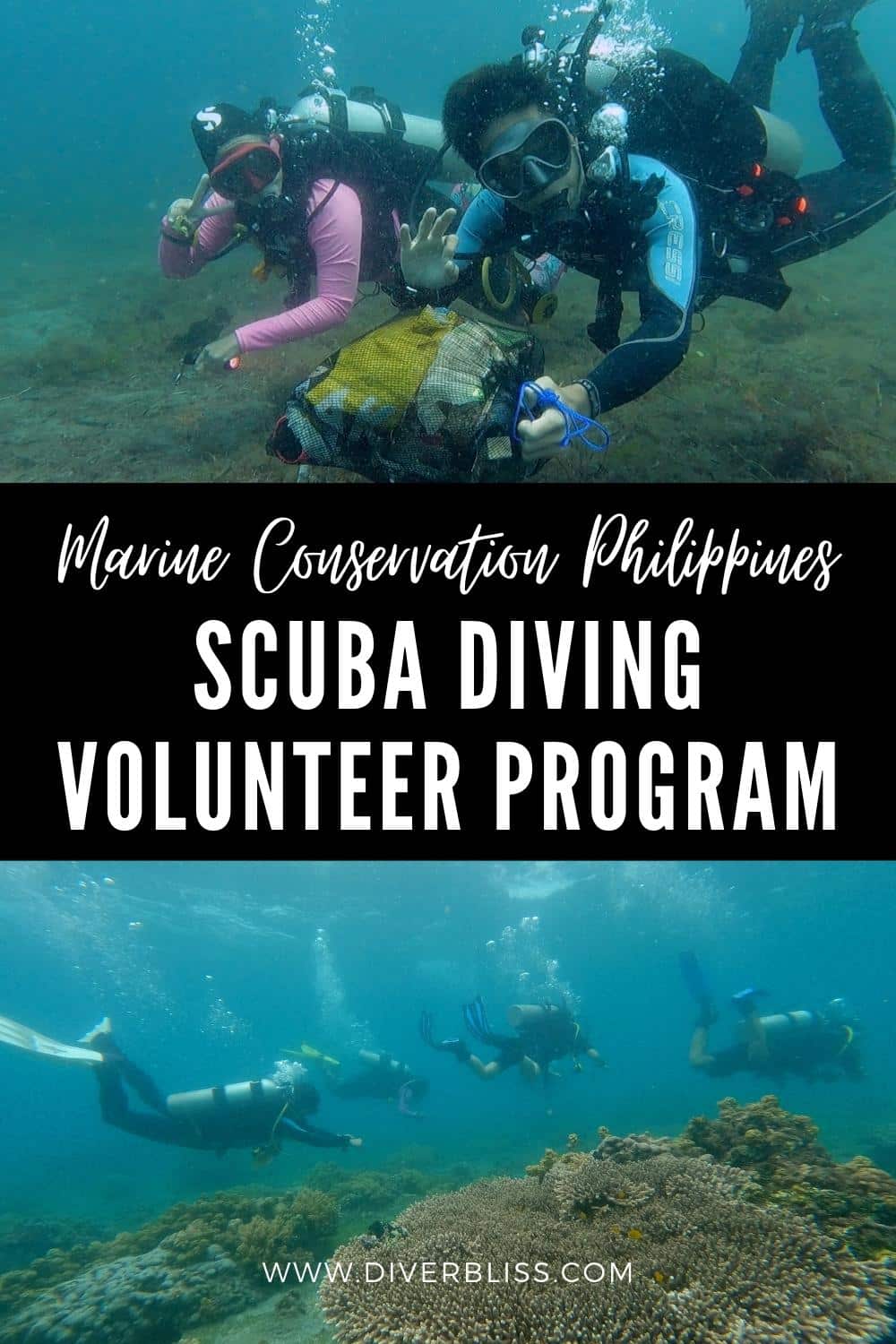
Have you joined a scuba diving volunteer program before? What was your experience like? What did you learn? Leave a comment below!
